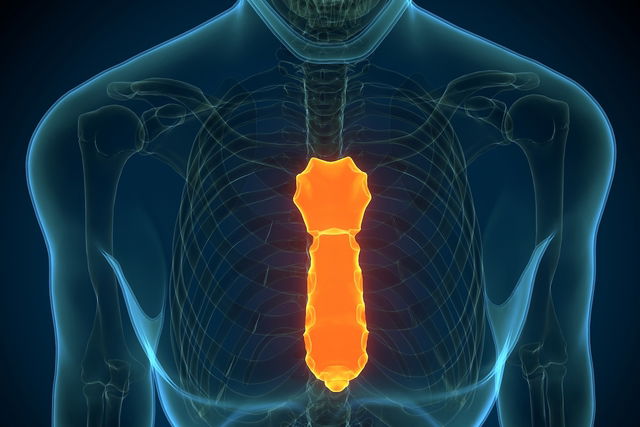Sternum pain can occur due to inflammation of the cartilage that connects the ribs to the sternum, which is the bone in the middle of the chest. This bone supports the clavicle and ribs, and information in this area is referred to as costochondritis.
Sternum pain is usually felt in the center of the chest. Pain intensity can vary depending on how you move your torso, whether your inhaling or turning and looking behind you. Some patients report this pain as a pressure sensation, which can be confused for a heart attack.
Also recommended: Pain in Middle of Chest: Top Causes & Symptoms tuasaude.com/en/pain-in-the-middle-of-the-chestCostochondritis is a common inflammation that usually does not require treatment, as it tends to disappear on its own. If the pain worsens or persists for several weeks, however, you should see a doctor, who may prescribe analgesics or anti-inflammatories.

Main symptoms
The main symptoms of costochondritis are:
- Fine, sharp or pressure-like pain in the middle of the chest
- Pain that worsens with movement
- Pain when coughing
- Pain when breathing
- Shortness of breath
- Sensitivity of the region to palpation
In normal situations, the cartilage on the ribs adjust for lung movements when breathing, however this movement can be difficult when this cartilage becomes swollen. Generally, pain is usually limited to one area, mainly the left side, but can radiate to other parts of the body, such as the back and abdomen.
Possible causes
Although there is no specific cause for sternum pain, there are certain body movements or situations that can lead to inflammation of this bone. Some possible causes include:
- Chest pressure (for example, a seat belt against the chest upon sudden breaking of the car)
- Bad posture
- Chest trauma or injury
- Extreme physical activity
- Deep breathing
- Coughing
- Sneezing
- Arthritis
- Fibromyalgia
In very serious cases, sternum pain can be a result of a thorax tumor, which can make breathing and swallowing difficult. This type of tumor can also cause symptoms like weight loss, hoarseness and chest pain.
In later stages of pregnancy, some women may also notice chest discomfort that worsens with activity and causes shortness of breath. This occurs due to ling compression from increased uterine size.
How to rule out Tietze syndrome
Sternal pain from costochondritis is often confused for Tietze syndrome, which is a condition characterized by chest pain from thoracic cartilage inflammation. The difference is that Tietze syndrome also affects causes swelling between the bone and cartilage, where they join.
Tietze syndrome is less common than costochondritis and can affect both men and women. It is more common in teens and young adults, and is characterized by pain in a single spot along with swelling. Possible causes, diagnosis and treatment is the similar to that of costochondritis.
Confirming a diagnosis
Sternum pain caused by to costochondritis is diagnosed through an assessment of the patient’s symptoms and previous health history. The doctor may also order imaging and tests to rule out other causes of chest pain, such as an ECG, chest x-ray, CT scan or MRI.
Treatment options
The initial recommendations for sternal pain are resting, applying warm compresses and avoiding movements that can worsen pain (like heavy lifting or high impact sports). The doctor may also recommend light stretching exercises to relieve pain.
In other cases, the doctor may prescribe analgesics or anti-inflammatories, like naproxen or ibuprofen to relieve pain. In more serious cases, the doctor may recommend injections to reduce activity in the nerve causing the pain. Also, depending on the type, degree and recurrence of pain, physiotherapy may be indicated.
When to see the doctor
You should seek medical attention if your sternal pain is accompanied by other symptoms like:
- Shortness of breath
- Pain that radiates to the arm or neck
- Worsening of pain
- Fever
- Difficulty sleeping
The doctor may order tests to rule out cardiac problems that may present similarly. Learn morea bout the symptoms of a heart attack that you shouldn’t ignore.
